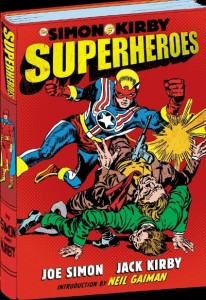Simon & Kirby Superheroes
Reviewed by Martin Skidmore 23-Jun-11
Nearly 500 pages of beautifully reproduced old comics by one of the medium’s key teams.
I can see why a £35/$50 price tag might put people off, but I found a copy in almost perfect condition for £9 on Amazon, so maybe you can too (this was pointed out to me by my friend, the Kirby expert Chrissie Harper). Not that it’s such bad value even at full price: nearly 500 pages of beautifully reproduced old comics by one of the medium’s key teams, almost all of it new to me. That may be less true of you: nearly 200 pages of it is Fighting American material that has been collected before, again in an expensive volume. That still leaves 300 pages of other material, of course, so I wouldn’t let that put you off completely.
It doesn’t start so well: the Black Owl is from 1940-41, and while the pencils are identifiably Kirby, the layouts don’t look like his (I expect that is due to its being early rather than their being by someone else), and it’s pretty dull. Still, there’s only about an issue’s worth of that, and then we move on to 1946, and Stuntman, which is much more the Kirby we know. This run (over 100 pages) is full of invention in story and art, and features some stunning work, not least a few double-page spreads of outstanding energy even by Kirby’s matchless standards. It also features one story inked in very clean and open style by, I think, Bill Draut, which is interesting.
A couple of less successful characters come next: a little of the Vagabond Prince from 1947, a hopelessly camp superhero, though I liked the New Orleansish setting; then Captain 3-D from 1953, originally in 3D, and you can see the adjustments Kirby made for this gimmick, though it is printed flat in full colour here. This run is also interesting because Steve Ditko had some early involvement in the inking.
Then it’s Fighting American, a Cap-type complete with kid sidekick. This ran from 1954-55 with one revival issue in 1966. The last two stories are not drawn by Kirby, but the rest of it is top quality, starting with some fairly straight red-bashing stories, but soon becoming silly and comedic, apparently in response to the extremities of the McCarthy era.
Finally we get nearly 100 pages of the Archie superheroes done by S&K in 1959: The Double Life of Private Strong is sort of a Shield revival, and perhaps gives the hero too much in the way of superpowers for the opponents (more commie spies in particular) he faces. This may be true of the Fly too, but this comes with some decent wrinkles, at least.
No, none of this is as great as the stuff Kirby largely wrote himself in the two decades after this, at Marvel and DC, but (barring the Black Owl) it isn’t merely of historical interest either. It does trace the development of surely the greatest figure in anglophone comics (and I do Simon an injustice here – he probably wrote nearly all of this, and it is a lively and enjoyable read), which is clearly valuable, but these are, with a few exceptions, also very entertaining comics in their own right, worth reading even if you have no interest in any historical significance.
Tags: Black Owl, Captain 3-D, Fighting American, Fly, Jack Kirby, Joe Simon, Stuntman, Titan, Vagabond Prince